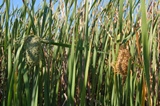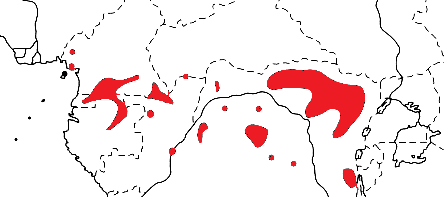Weaver species
Choose different species from drop-down list and press 'Go' button. See Full species list.Red-crowned Malimbe Malimbus coronatus
IUCN: Least concern Discovery: 104Categories: cooperative, Malimbus, black,
News items about species
Discovery
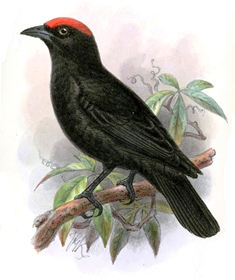
figure from Sharpe (1908) 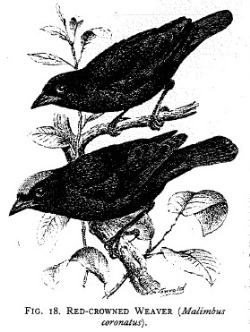
figure from Bannerman (1949) 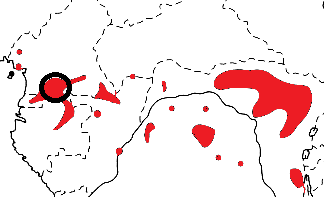
distribution, type locality circled IntroductionThe Red-crowned Malimbe was formally described by Richard Bowdler Sharpe, an English zoologist and ornithologist who worked as curator of the bird collection at the British Museum of natural history.The Red-crowned Malimbe was collected by George Latimer Bates, an American naturalist. Bates visited West Africa in 1895, first to Gabon and later he moved to the south east Cameroon, making a living by farming. In 1905 he settled on the Ja River, calling his farm Bitjie or Bitye (after the Bulu pronunciation of his name). He collected many natural history specimens, especially birds, in his travels and sent many of these to the Natural History Museum in London. Bates collected a male Red-crowned Malimbe near the River Ja, probably near his farm Bitye, together with Bates's Nightjar Caprimulgus batesi, and these were described as new species by Sharpe. Bates continued observing this malimbe and collecting more specimens. By collecting pairs at the nest, he realised that the females were all-black. By dissecting juveniles Bates realised that they all had an orange crown - females later moult the crown into black feathers. In 1928 Bates moved to England and wrote a Handbook on the Birds of West Africa (1930). The Red-crowned Malimbe was first illustrated by Sharpe (1908), showing the male type. The next illustration to be published was a line drawing in Bannerman (1949), showing the male and female. Scientific citationMalimbus coronatus Sharpe 1906a, Bull. Br. Orn. Club 19 p.18, River Ja, Cameroons.Meaning of namescoronatus, Latin: coronatus, crowned (coronare, to crown).First English nameRed-crowned Malimbe (Sclater 1930a) and Orange-crowned Malimbus (Bates 1930a).Alternate namesOrange-crowned Malimbus, The Red-crowned Weaver.CollectorGeorge Latimer Bates.Date collected18 Feb 1906.Locality collectedRiver Ja, Cameroon.Type specimensThe type is in the Brisitsh Museum (BM 1908.5.25.100). |
The above is based on Weaver Wednesday 2, a weekly series about the discovery of each weaver species.
This species text first appeared as
Weaver Wednesday [221] - Discovery [104]: Red-crowned Malimbe on 2016-09-07
1. Basic biology
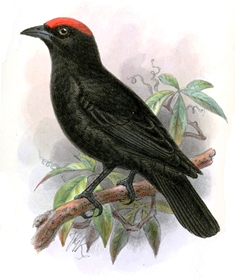
figure from Sharpe 1908 Juveniles are distinctive, and juveniles of both sexes are sooty brown with an orange crown patch, and horn bill. Female Malimbe identification in the hand:
Distribution. The Red-crowned Malimbe is localized but common, occurring in central Africa. It occurs in Cameroon, Central African Republic, Equatorial Guinea, Gabon, Congo and DRC (see map below, based on Birds of Africa). There are no subspecies of the Red-crowned Malimbe.
Habitat. The Red-crowned Malimbe inhabits primary lowland forest, sometimes in swamp forest, mature secondary forest and orchards. Food.
The Red-crowned Malimbe feeds on caterpillars, grasshoppers, cockoaches, small beetles and insect eggs. Nestlings are given grasshoppers and caterpillars. Birds forage in the canopy, often in dense screens of hanging lianas and clusters of leaves. They occur in pairs or groups of up to 7 adults; and often in mixed-species foraging flocks.
Breeding. The Red-crowned Malimbe is a monogamous, solitary nester. The nest is built collaboratively by up to 6 adults. When the nest is complete, the helpers disappear and only the breeding pair remains. The nest is an untidy, pendent structure made almost entirely of dead, dry plant material. Nest material includes vine tendrils (sometimes spiral ones); interwoven with small, bent or straight twigs and small and large petioles. The egg chamber is suspended by a long anchoring structure from a thin thorny liana stem or tip. There is a short but wide entrance tube. The outer parts of the nest have many outward and downward pointing stiff stems embedded into them. The whole, hedgehog-like nest is thought to be an effective anti-predator structure. The nest is sited above an open airspace, sometimes a path, usually at a height of 8-9m but up to 25m high. Adults find it difficult to fasten the first dry twigs and tendrils to a hanging vine and most material falls down at the early stages of building. As a result most nests are abandoned during the course of building. Nest-building is by a group of birds that arrive together and work in bouts, birds coming to work at the nest one after the other and calling continuously. Males and females work to the same degree, and a nest takes 2 weeks to complete. Both parents incubate and feed the young. Many nests are destroyed by chimpanzees Pan troglodytes. The Red-crowned Malimbe roosts in old nests at night and sometimes rests in them by day. |
The above is based on Weaver Wednesday, a weekly series about weaver species.
This species text first appeared as
Weaver Wednesday [52]: Red-crowned Malimbe on 2013-06-12
2. Breeding facts
| Pair bond Monogamous Breeding season mainly Nov-Feb (also Mar-Apr) in Gabon, Dec and Mar in PRCongo, and Jan-Mar and Sept in DRCongo Nest site suspended 7-25 m (usually 8-9 m) above ground from dangling thorny vines, usually over open space or clearing Nest building Group of 3-6 individuals may participate in nest-building, then single pair left to breed Colony size Of 18 nests in Gabon, two built by single pair, two by two males and one female, three by one male with two females, four by two males and two females, six by three males and two females, and one by two males and three females Clutch size apparently 2 eggs Egg colour eggs undescribed Egg size no information Incubation incubation by both sexes, nest seldom unattended, no information on duration of incubation period Chicks and nestling period both sexes brood and feed chicks, no information on duration of nestling period |
Breeding information based on Handbook of the Birds of the World, Vol. 15.
3. Photos of Weaver Nests
 Vm 3663 |
Thumb-nails of most recent PHOWN records - click on one to see its full record
See all PHOWN records for this species here.
PHOWN (Photos of Weaver Nests) provides valuable info on breeding distribution and colony sizes of weavers.
You can contribute by registering and submitting photos at Virtual Museum webpage.
4. Breeding distribution
Google map showing distribution (For species with small ranges you need to zoom in at the correct area to see the range):
yellow blob - range of weaver species; read more about this here.
![]() - PHOWN records with photos
- PHOWN records with photos
![]() - PHOWN records with no photos (Nest Record Cards, other records)
- PHOWN records with no photos (Nest Record Cards, other records)
![]() - Birdpix records
- Birdpix records
![]() - comments on out of range records, or interesting records
- comments on out of range records, or interesting records
![]() - type locality
- type locality
CLICK on the marker on the map to see individual record details.
5. Range changes
Not South African speciesThe above is based on Weaver Wednesday 3, a weekly series about range changes in South African weaver species.
This species text first appeared as
n/a








